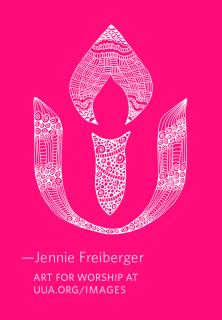Your Gifts Are Welcome

This ritual provides an opportunity for people to bless one another, look into other’s eyes with respect and acknowledge the sacredness within. People may participate while seated or standing or may choose to sit in silent meditation or prayer instead.
We travel together on a search for meaning, having come from many different places and bringing many different gifts to share for the journey. Bless those who bring the gift of courage. Bless those who bring the gift of love. Bless those who bring the gift of curiosity. Bless those who bring the gift of hospitality.
I’d like you to turn to your neighbors, to face one person at a time with focus and intention, and to give and receive the message, “Your gifts are welcome on this journey.” If you need help remembering, the words are written in your order of service. We’ll take a moment when you can bless and be blessed by two or three people near you. If you choose not to participate out loud, you are welcome to fold your hands and close your eyes in meditation and know that your neighbors will appreciate you from afar. In any case, please hear from me: “Your gifts are welcome on this journey.” Please bless one another.
A Note From Rev. Lyn Cox
This blessing was written for a Wizard of Oz-themed multigenerational service in which we welcomed different gifts that we bring together in community for our shared journey. In the story, we remember the gifts of brain, heart, courage, and home. In our faith communities, people bring these and many other gifts, and all of these gifts are needed for us to face the challenges of our path together.
This moment is meant to have a more intentional liturgical tone than greet-your-neighbor, yet allows people to move their bodies and to be optimistic and joyful as they face each other. This element might follow a pastoral prayer in which the congregation reflects on confession and commitment as well as gratitude and hope, serving as a ritual of reconciliation similar to passing-of-the-peace. In the service this blessing was drawn from, the pastoral prayer had happened earlier in the worship and the blessing immediately followed a lay leader’s reflection on the people and activities that enrich and enliven our community’s spiritual life. The congregation’s attention was re-focused after the blessing by the piano introduction of a lively and familiar hymn.
| Date added | |
|---|---|
| Tagged as |